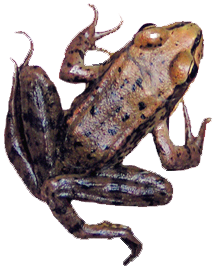December 8, 2015
The day’s steady rain persisted as the sun set, the air a very warm 60 F. With the conditions perfect we were expecting a big frog night. It also happened to be the night of our volunteer training up the highway at the community center, since when we scheduled the training we weren’t expecting frog movement till much later in the month. Until the meeting was over after 8 PM, it was just Panos Stratis and I, and it wasn’t clear Panos could make it, as the weather had made traffic chaotic. I got down to the frog crossing struggling with a tall stack of buckets and the box with traffic vests and head lamps, nervous I’d be overwhelmed, overrun and tied down by hordes of hopping Lilliputians. Then Panos arrived, Jeff Booth showing up unexpectedly, and then Sue as well, as the volunteer training had been canceled: a landslide on the other side of the St Johns Bridge, about two miles south of us, had choked off the highway and cut power, but rerouted around the slide, the rush hour traffic going by us on the highway was as tenacious as ever.
We started catching frogs. Then Shawn arrived as well. Panos patrolled the cliff along the highway, Jeff was up Harborton past the falls, and Shawn and I roamed the road between them, where we generally caught the vast majority of frogs coming down the Harborton Creek ravine. We’re experimenting with fabric hung from the guard rail on Harborton to see if it stops the frogs, making them easier to catch. (It definitely helps, but the frogs climb over it, given time.) Sue started ferrying frogs to the pond, as she likes to count and sex the frogs as she releases them. She mentioned to me that several miles to the north another population of frogs was getting slaughtered on the highway, and that we’d have to start thinking about that. Panos and Jeff were catching double what Shawn and I were getting. We’d never caught so many so far up the road before. It looked suspiciously like the frogs were attempting to avoid us, trying to slip by to the south and north by coming down sheer cliffs.
North Cliff, Harborton Drive
South Cliff, St. Helens Rd.
These frogs are great climbers, with their strong hands and opposable thumbs. But the possibility they’re anticipating us, changing their route coming out of the forest, is intriguing. I imagine them like Indian scouts up in the ferns and grasses, looking down on our wandering head lamps, then creeping down the cliffs looking for safe passage. The notion that they’re instinct-driven knuckle draggers with a hop in their step, is, I think, off the mark. Twice this night when I bent over to pick up a frog frozen in my head lamp, the hood of my raincoat fell over the light, and the frogs, only three feet away, had disappeared when I pushed the hood back. I quickly swept the pavement with light, amazed they escaped so quickly and completely. Other frogs this night evaded me (they seemed to be quicker and more lively in the 60 degree air), sweeping by in water flowing down the gutters, leaping between my feet, making a hell bent dash to get off the pavement and into the leaves. Their tactics struck me as creative; they made split second decisions that made excellent use of the limited options open to them.
Plunging into four lanes of rush hour traffic seems suicidal, or stupid, but they’ve no choice as we’ve relentlessly reduced their habitat and introduced all kinds of daunting obstacles. The frogs were waiting in the vegetation for Cyclops with the searchlight eye to go away, so they could make a break for it, and Jeff and Panos were both great at spotting them and plucking them from the grass, the ivy. We caught 360 frogs, 255 males, 105 females, one of the biggest nights of the three year effort.




